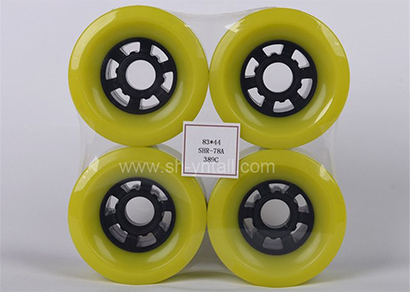Some Information About Skateboard Wheels
1.What are skateboards made of?
In the old days of skateboarding, skateboards were made of metal. The wheels are actually used by the skates, but the skater still attaches them to the board. Fortunately, this practice came to an end in the 1970s when Frank Nasworthy invented the first carbamate wheel.
Since then, skateboards have been made of plastic polyurethane. However, it is often called polyurethane. This versatile material, which can be made to varying degrees of hardness, dominates the skateboard market.
However, not all polyurethanes are the same, and not all wheels are the same. Different skateboard wheel brands have been experimenting with new material mixes to make the wheels more durable, faster, smoother, and slide better, and to make them particularly resistant to flat points.
2.PU skateboard wheels: What is a flat point?
To taxi (plate lateral rotation and perpendicular to the rolling direction sliding on all four wheels to slow the progress of the plate), 180 taxies (at the sliding plate rotating 180 ° without doing any lift a finger or other skills) such as sliding skills, such as cog is likely to be severe abrasion wheel, and form a flat spot on the wheel. When this happens, your wheel will no longer be perfectly round, so it won't roll properly. This is most often seen with soft wheels.
3.Slide wheel: standard wheel and core wheel
The basic difference between a skateboard wheel is the standard wheel and the core wheel. Compared to a standard wheel (also known as a "non-core wheel"), a core wheel has a plastic core that is harder than the rest of the wheel. The plastic core reduces weight and also helps keep the bearings in place, preventing them from pressing into the wheel.
4.Skateboard wheels: How to choose a wheel
When buying wheels, make sure the size and hardness are appropriate for your setting and skating style. But don't panic. We will let you know the different wheel sizes, stiffness levels, and contact spots.
1)Skateboard wheel: The right height
Skateboards come in different sizes. Dimensions show the diameter of the wheel in millimeters (mm). Usually, the skateboard wheel is between 50 mm and 59 mm in diameter. Anything larger will not fit on your skateboard and will fit on a cruiser or longboard.
Smaller wheels accelerate faster and are lighter and more compact. However, their top speed is lower than that of larger wheels. In addition, with larger wheels, you'll be on the safe side when riding over rough terrain, as they won't be blocked by every small stone that crosses your path. Larger wheels are designed for higher speeds and are more durable.
2)Skateboard wheel: suitable hardness
Another thing to keep in mind when buying skateboards is rigidity.
How to describe the hardness of the skateboard wheel?
The hardness of the sliding meters is given by "Durometers" in "A". The so-called A scale is A 100 point scale, and the skateboard is rated between 75A and 100A. The higher the number, the harder the wheel.
3)Skateboard wheel: Correct contact patch
After choosing the diameter and hardness, choosing the right contact patch is the last criterion that must be determined when choosing the right wheel for a skateboard.
This area is the part of the wheel that keeps in contact with the ground.
5.Prolong the service life of wheels
Every skater has his or her own skating preferences. Whether it's your typical route on a skateboard or whether you prefer to power ride on the front or back, this will affect wheel wear. PU wheels for skateboard manufacturer indicates, to avoid single wheel wear, you can regularly change the wheel position to make the wheel wear evenly.
•Option 1: You can easily turn the wheel. Remove the side of the wheel that was facing out, and then face in.

•Option 2: It is more efficient to switch wheels in X mode. In other words, the right front wheel is interchangeable with the left rear wheel, and the left rear wheel is interchangeable with the right rear wheel.
评论
发表评论